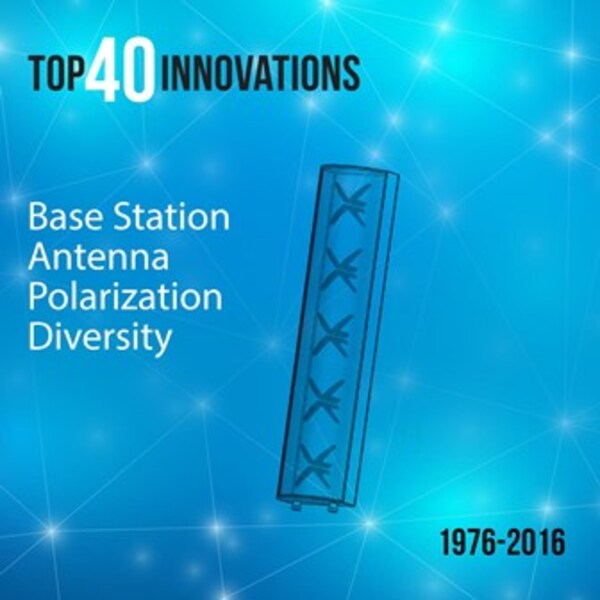
CommScope’s Top 40 Innovations—Grouping 1-10
Base Station Antenna Polarization Diversity
Definition: In a wireless network, polarization diversity makes it possible for operators to deploy one base station antenna instead of two while achieving the required diversity needed for reliable communications.
Year of the Innovation: 1995
What is the innovation that CommScope or one of its acquired companies was first in creating?
Initially wireless mobile systems used two single-polarized antennas, physically spaced at least 10 wavelengths apart, to provide what is known as space diversity. Single-pol required a large platform on the tower and increased the cost, weight and wind loading.
Polarization diversity technology, called dual or cross polarization, offered a significant advantage in that it can be implemented within the same size factor as a single-pol antenna. Polarization diversity allows for the deployment of a single antenna housing wherein space diversity required deploying two antennas.
DualPol was the brand name for the first polarization diversity antennas, which became part of CommScope through company acquisitions. DualPol technology is still in use today in virtually all CommScope antenna products for all sectors of the wireless industry. DualPol antennas have saved operators millions of dollars in deployment costs and have made zoning issues easier because the antenna structures are more compact and can be placed on power poles or disguised as flagpoles and other structures.
What was happening in the market that this innovation was needed?
Signal fading is a problem in wireless systems, and diversity is critical to helping to counteract the effects of fading. The idea behind diversity is that instead of using just one antenna, the system uses two or more antennas. Signal fade occurs on individual antennas, and diversity ensures that at least one antenna will have a strong signal even if the other fades.
Another factor that drove the need for diversity is that normally the transmitters at the cell tower are around 20 watts, while a mobile phone transmits at hundreds of milliwatts, so the downlink signal has a big advantage over the uplink signal. Diversity helps the low-power handets get on performance par with the higher power cell site equipment.
Prior to the advent of cross polarized (cross pol) antennas, the primary method for implementing diversity was by putting two vertical polarized antennas 10-20 wavelengths apart on a tower. At 1-2 GHz frequency ranges, this meant placing antennas 10-20 feet apart, which required large, triangular structures on cell towers. Cross pol technology co-locates two radiators in one unit, enabling two antenna arrays to occupy the same size housing as a single pol antenna. This significantly reduces the amount of real estate required at the cell tower.
How did this innovation benefit customers and the industry?
Implementing antenna polarization diversity in CommScope products has enabled mobile operators to minimize cell site deployment time and costs, and to greatly expand the number of acceptable locations for cell sites. CommScope’s polarization diversity technology has set the standard for antennas used by virtually every mobile operator in the market.
Did this innovation act as the springboard for other innovations, and if so, how do they all tie together?
Over the years, CommScope and its acquired companies have continually evolved DualPol products to meet changing market needs. Initial products supported 800 MHz cellular frequencies, for example, and subsequent products supported 1900 MHz and other frequencies as 3G and 4G cellular technology emerged.
When multiple input-multiple output (MIMO) technology appeared in cellular networks, CommScope DualPol antennas supported it. MIMO is an important technology for mobile operators because it uses two or more divergent radio paths to increase the throughput of the cell site by approximately the ratio of the number of added paths. A single DualPol array supports 2x2 MIMO (two antennas), while two DualPol arrays side-by-side support 4x4 MIMO (four antennas). The same technology will be used in so-called “massive MIMO” systems of the future, which will use dozens or hundreds of antennas.
Another innovation was the development of antennas that support multiple bands. The latest CommScope antennas combine high-band and low-band antenna elements in the same enclosure to minimize distortion and save further space and deployment time in cell sites.
What is the significance of the innovation for CommScope?
Today, CommScope is a leader in mobile network antenna technology. DualPol antennas have set the standard for antenna deployments worldwide, and CommScope continues on the path of further innovation.







